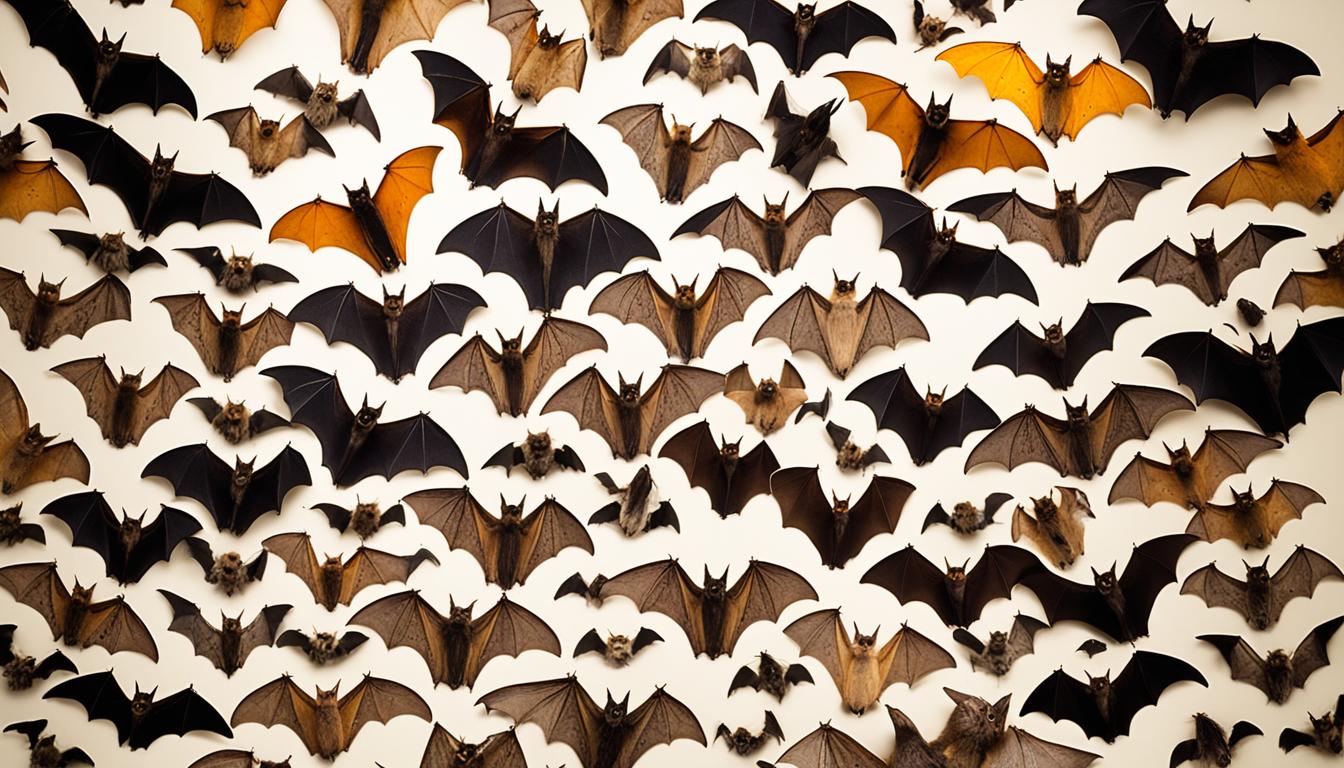There are over 1,300 bat species around the world and 51 in the US. Have you ever wanted to know how to tell them apart in your area? This is important for both science and keeping people safe.
Knowing which species of bat is which is crucial. It helps us check for diseases that can spread from animals to people, like rabies. This information is key for all interested in bats, from fans to health experts. But can you identify bats correctly with just some simple tools? A detailed guide on American bats is here to help. It has all you need to spot the different types of bats.
A special key helps you figure out which bat is which by looking at important features. This guide is a big help in saving these important animals.
Understanding the Importance of Identifying Bat Species
The need to identify bat species comes from their different roles in nature and their looks. It’s key for dealing with diseases, especially rabies. With the right species ID, health workers can see which rabies types each bat kind carries. This helps create better ways to stop the spread of these diseases.
Knowing the specific features of different types of bats isn’t just for scientists. It’s also for those who make health rules. Special guides and keys help improve what we know and keep us safe. They teach us about the environment and any risks from each bat species.
Figuring out which bat is which is crucial for fighting diseases. It isn’t just a science thing; it’s how we protect each other. Knowing the species helps focus on where rabies is, making health actions more effective.
A table below shows why figuring out bat species is so vital:
| Reason | Explanation |
|---|---|
| Ecological Diversity | Understanding the diverse roles bats play in ecosystems. |
| Morphological Characteristics | Accurate differentiation based on physical traits. |
| Disease Management | Managing risks related to zoonotic diseases like rabies. |
| Public Health Safety | Informing health officials for better disease control strategies. |
| Scientific Knowledge Advancement | Enhancing the broader understanding of bat species. |
General Characteristics of Bats Found in the USA
Bats in the United States show a wide variety of traits. Knowing this helps in teaching and saving them. Part of learning about bats is understanding their body parts like the uropatagium and tail length. This knowledge is key for telling bat species apart. It’s essential for a full guide about bats in the USA.
Basic Anatomy of Bats
The basic structure of bats is both detailed and diverse. They have unique features like the uropatagium and different wing shapes. When we look closely, we can see these differences help us know which bat is which. Where bats live is also important. Some bats only live in certain places.
Ecological Roles of Bats
American bats play a big part in nature’s cycle. They help pollinate, spread seeds, and eat insects at night. All of these jobs help keep our world in balance. Knowing the right bat species is crucial for keeping an eye on and protecting these important animals.
Physical Characteristics to Distinguish Bat Species
Spotting the unique traits of bats is key to telling species apart. Look at things like how big they are, the length of their ears, and what their tails are like. These details help identify different types of bats accurately.
Size and Shape Variations
Exploring the size and shape of bats is a major way to understand their differences. Bats come in various body sizes and wing shapes. Measuring them precisely using tools like calipers is the best approach.
These measurements are vital when trying to separate similar-looking bats. It’s one of the main steps in figuring out which bat is which.
Ear and Tail Features
Looking at a bat’s ears and tail is also crucial for identification. Details like ear and tail length, including special features, are important. This includes features like the calcar’s keel and the plagiopatagium. They help pinpoint exactly which type of bat you’re dealing with.
By getting up close and personal with these body parts, you’re more likely to identify them correctly. This is true even if the bats are alike in their general body shape and size.
Geographic Distribution of Bat Species in the USA
It’s key to know where bat species live in the USA bat species distribution. This helps in identifying and protecting different types of bats. Knowing where bats usually live lets you guess which kinds you might find in America.
Bat species range maps are very useful. They show where bats might be found, considering things like their movement and changes in climate. These maps work for all U.S. states, including Alaska and Hawaii, giving great insights into where bats are.
This guide tells us about bats found in many states. Using these maps and what we know about USA bat species distribution helps us identify bats in specific regions. They’re easy to use and help both fans and scientists understand bat protection and spotting in the U.S.
Using a Bat Identification Key
Bat enthusiasts and researchers find great use in bat identification keys. These keys help identify bat species in a step-by-step way. They are useful for anyone interested, making the tricky task of identification easier.
Introduction to Dichotomous Keys
Knowing how to use a dichotomous bat key is key for accurate identification. This key works by giving options about what the bat looks like. It focuses on even small details, ensuring a correct match.
Step-by-step Guide
To identify a bat species, use this clear step-by-step guide:
- Prepare Your Tools: Get a ruler or caliper, a field guide, and the key.
- Observe Morphological Features: Look at the bat and note ear shape, tail membrane, and wing.
- Make Comparisons: Use the key to match your observations with its choices.
- Proceed Through the Key: Keep choosing based on what you observe until you find the right bat.
- Verify Your Findings: Double-check with guides to be sure of your identification.
Following these steps methodically helps you use bat keys well. It makes the whole identification process more efficient and accurate.
Behavioral Traits and Echolocation
Learning about bats’ behaviors and how they use echolocation helps identify different bat species. By watching how they eat and listening to their sounds, we can figure out which bat is which.
Feeding Habits
Bats eat in various ways, depending on the type. Some bats fly fast and catch bugs out of the air, like those who eat insects. Others like to eat fruits. Watching them eat gives us clues about who they are.
Echolocation Calls
Bats make sounds to find food, and each type of bat uses a different sound. These sounds help them catch their preferred prey. Smaller bats make quick, high-pitched sounds to find tiny bugs. On the other hand, larger bats make slower, deeper sounds to find larger prey.
| Parameter | Small Bats | Large Bats |
|---|---|---|
| Call Frequency | High | Low |
| Preferred Prey | Small Insects | Larger Insects or Small Animals |
| Feeding Behavior | Agile, rapid hunting | Slow, deliberate hunting |
Watching how bats eat and listening to their sounds together helps us learn more about them. This method is key for protecting them and studying them.
Common Bat Species in the United States
The United States has many common American bat species due to its various climates. You can find the little brown bat and the big brown bat across the country. Each has special features that help them survive in their environments. Knowing about these bats can teach us a lot about the world around us.
The little brown bat is known for its tiny size and shiny, dark fur. It likes to live in caves, buildings, and tree holes. On the other hand, the big brown bat is larger with lighter fur. It does well in forests and even cities.
The California myotis is a bat that stands out in the western states. It is known for being able to live in different altitudes and climates. Then there’s the spotted bat. It’s rare but its black and white spots make it easy to recognize.
| Species | Habitat | Distinctive Traits |
|---|---|---|
| Little Brown Bat | Caves, buildings, tree hollows | Small size, dark glossy fur |
| Big Brown Bat | Forests, urban areas | Robust build, lighter fur |
| California Myotis | Various altitudes and climates in western states | High adaptability |
| Spotted Bat | Varied, often elusive habitats | Black and white spotted appearance |
All these bat species in the United States are important to their ecosystems. They help with things like eating pests and pollinating plants. Learning about these bats helps with their protection.
Western Bats vs. Eastern Bats
In the United States, the type of bats you find can differ greatly between the west and east. This is mainly due to the climate and environment in each area. Knowing this can help you guess what kinds of bats are around when you visit different spots.
Habitat Preferences
Bats in the west like dry or somewhat dry places. They love areas with lots of caves and small openings in rocks to rest in. On the other hand, bats in the east prefer damp places. They find shelter in forests, buildings, and trees. This shows how much climate and the type of places to hide in affect where bats live.
Species Examples
Different habitats mean different bats in each area. In the western United States, you find bats like the Pallid Bat and the Mexican Free-tailed Bat more often. But in the east, you’re likely to see the Little Brown Bat and the Indiana Bat instead.
| Region | Common Species | Habitat Preferences |
|---|---|---|
| Western USA | Pallid Bat, Mexican Free-tailed Bat | Arid/semi-arid regions with caves and rock crevices |
| Eastern USA | Little Brown Bat, Indiana Bat | Humid environments with forests, buildings, and trees |
By learning about these differences in where bats like to live, you can get better at spotting western and eastern bats. This way, you’ll know what makes each kind of bat unique.
Threats to Bat Populations
American bats face serious threats like white-nose syndrome, habitat loss, and climate change. First found in 2006, White-nose syndrome has harmed bat populations greatly. It affects their sleep, putting many at risk.
Loss of homes is a big problem for bats. Cities, farming, and cutting down forests take away places for them to live and find food. Without enough caves or hiding spots, bats struggle to survive. This is made worse by fewer bugs to eat because of pesticides and changes in the weather.
“The health of bat populations is a vital indicator of our ecosystem’s health, and their decline can signify broader environmental issues,” explains the U.S. Fish and Wildlife Service.

We need to act fast to help bats. Protecting their homes, fighting white-nose syndrome, and addressing climate change are key. Educating the public is also important. It helps people understand why bats matter and how to help them.
| Threat | Description |
|---|---|
| White-nose Syndrome | Fungal disease disrupting hibernation and causing high mortality rates. |
| Habitat Destruction | Urban development and deforestation reducing natural roosting and foraging areas. |
| Insect Prey Decline | Climate change and pesticide use reducing insect populations, lowering food availability for bats. |
It’s vital to understand these threats to bats. By tackling these problems, we can help save bat populations. This is key to keeping our ecosystems healthy.
Tools and Resources for Bat Identification
You have many ways to identify bats. There are tools and resources for anyone interested. These help you know the types of bats you see. Here are some great tools to help:
Field Guides and Apps
Field guides and apps are perfect for bat spotting. They show bat species with detailed info and pictures. This makes it easy to tell bats apart. Apps let you hear bat sounds, check where they live, and learn special things about each type, all on your phone.
Local Wildlife Organizations
Local wildlife groups are also helpful. They hold events and projects where you can learn about bats up close. You get to practice using tools and help protect bats. If you have questions, they’re ready to help over the phone or online.
| Resource | Description | Benefits |
|---|---|---|
| Field Guides | Books or pamphlets with detailed information and images. | Easy to carry, comprehensive visual aids. |
| Mobile Apps | Applications that offer interactive identification features. | Convenience, sound libraries, and up-to-date information. |
| Wildlife Organizations | Local groups offering workshops and online resources. | Hands-on learning, personalized guidance, and community involvement. |
Field Methods for Identifying Bats
To ID bat species in the wild, night surveys and bat detectors are key. They help gather important data when bats are active. This info is critical for their protection and studying nature.
Night Surveys
Night surveys mean watching bats when they come out at sunset. You place yourself where bats hang out, like by water or forests. Here, you note how many bats you see, how they fly, and other details. This helps understand where bats live and what they like.
Use of Bat Detectors
Bat detectors are a must for spotting bats in the field. They change bat sounds into noises people can hear. By listening and recording, you can figure out which bats are there. New detectors often have apps that help ID the bat sounds. This technique is key for knowing who’s around and what they’re doing.
Using both surveys and detectors boosts how accurate your studies are. Anyone interested, from pros to regular folks, can use these methods. They’re crucial for learning more about bats and their big job in nature.










